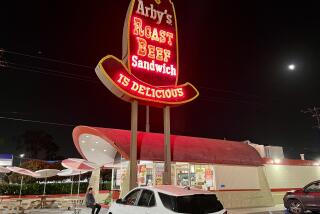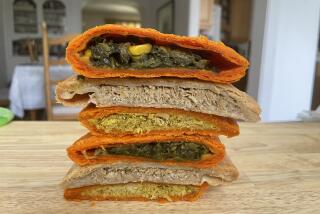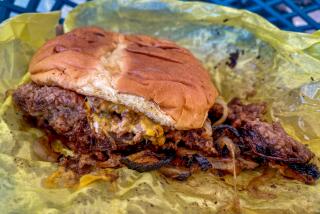Chew on This: Beef Jerky Is Pride of Owens Valley
OLANCHA, Calif. — The first sign that you are headed into a culinary oasis is on northbound U.S. 395, about 160 miles from L.A., at the southern edge of the Owens Valley. Sitting on the right shoulder, amid the desert brush, a small billboard reads:
“Really Good! Fresh Jerky 30 Miles.”
The hand-painted sign looks like the work of an amateur, and its message is perplexing. Can a piece of desiccated beef that resembles tree bark really be called fresh?
Two more billboards direct motorists to an ancient gas station on the outskirts of Olancha (population 100). The parking lot on this winter afternoon is filled. It’s always filled.
One by one, motorists get out of their cars, walk inside a tiny store in the gas station, then exit holding a plain brown bag. A few quickly drive away. Most sit behind the wheel of their parked cars, struggling to rip open plastic-wrapped sacks of jerky with their teeth.
“We have two kinds of clients,” says Gus Niepagen, owner of Gus’ Fresh Jerky. “The ones serious about the outdoors and the ones going up to Mammoth for the weekend. They both need jerky.
“One needs the food; the other needs something to shut the kids up,” he says. “With each bag I guarantee at least 10 minutes of total silence from the back seat.’
As wine and cheese define Napa or Sonoma, jerky evokes the expansive, mostly undeveloped Owens Valley with its enduring pioneer flavor.
Of course, the valley is hardly the only locale where jerky is popular. Hunters, hikers, bikers and horsemen also gobble up prolific amounts of the stuff from New England to the bayous of Louisiana to the Great Plains to the northern Rockies.
But talk to enough outdoors people in California, and they’ll tell you there is no other place in the state where the chewy strips are so eagerly sought and even revered. On weekends, thousands of pounds of the stuff move off store shelves all over the valley, where some roadside shops even cure their own.
‘Back-Country, Horse-Packer, Cowboy Thing’
Jerky is not just another snack in the Owens Valley. It’s fast food in a region that the big chains haven’t colonized.
“We get calls and e-mails all the time” from people who want to know where to get jerky, says Susanna Ruland of the Bishop Chamber of Commerce. “I think it’s a back-country, horse-packer and cowboy thing, but I guess people also get on beef jerky when they’re trying to get off the chew.”
This region is known for the many westerns filmed here and renowned as a gateway for horse trips into the High Sierra. Jerky is saddlebag food. It can be stomped on by a horse, run over by a jeep, or buried in a backpack for weeks without losing any of its savor.
Danica Berner, who has lived in the Owens Valley for 31 years, co-owns Sequoia Kings Pack Train, which takes visitors into the recesses of Sequoia and Kings Canyon National Parks, high above the town of Independence.
One of jerky’s obvious benefits, she says, is that, unlike bread or candy bars, it doesn’t “squish up” when stuffed into the bottom of a backpack or saddlebag.
She also sees jerky as a food that links the land to the people and the people to their ancestors. It’s fare that people can chew while sitting on a rock in the high country and contemplating some of the nation’s most dramatic alpine vistas.
“People want to connect with the culture up here and the communities when they visit,” she says. “They don’t want to go to the huge supermarkets like Vons. Maybe they want to stop and get jerky in Bishop because their families have been stopping in Bishop for generations getting jerky.”
The recipe comes from the Indians, who often took jerky on their travels.
“The version of beef jerky that most Americans know is really profoundly native,” says Rayna Green of the Smithsonian Institution. “Most folks learned the medium of what they call beef jerky in the latter part of the 18th and early 19th centuries, mostly from Indians in the Midwest and the West.’
On the frontier, jerky was often an afterthought, made of leftover beef still worth too much to throw to the dogs. In the New West--where the Old West is cleaned up, repackaged and sold to tourists--jerky is not made from leftovers. It is crafted from choice cuts, prepared by marinating meat in a variety of spices and then thoroughly drying it.
Aficionados have dried virtually every kind of meat they can get their hands on--including ostrich, alligator, wild boar and bison. A category of food called meat snacks, which includes jerky, quietly crept past potato chips and cookies in the mid-1990s to become America’s fastest-growing type of snack, according to the Snack Food Assn., a national group based in Alexandria, Va.
One of the more interesting explanations for this comes from Susan Bowerman of UCLA’s Center for Human Nutrition. She says more Americans than ever are eating at gas stations, many of which have convenience stores. (Bowerman also points to the very real difference between jerky and the seemingly ubiquitous Slim Jim meat stick, which is high in saturated fat and lists “mechanically separated chicken” as an ingredient.)
Back in the Owens Valley, the undisputed jerky champ is Mahogany Smoked Meats in Bishop, where a pound of the stuff can cost $36.
Established in 1922, the store is a throwback to another era. Several fine bucks are mounted on the wall, and the place hums with the activity of employees drying jerky and smoking meats. On a typical weekend, more than 1,000 pounds of jerky are sold.
At the center of the store is a simple 25-foot counter that is nothing less than a shrine to meat: bacon, ham, pork chops, sausage and a wide variety of jerky.
There is no mention anywhere of “trans-fatty acids” or “polyunsaturated fat.” The store often smells like smoked bacon, also a big seller. Some customers are so overcome by the plumpness and vigor of the jerkies and other meats that they are momentarily tongue-tied, unable to formulate a coherent order.
Brandon Mojarro runs the store for his mother, who is the owner. He holds a master’s degree in business administration and has pushed to expand sales over the Internet.
Shortly after Mojarro moved back to Bishop, Gus Niepagen opened his jerky stand at the southern end of the Owens Valley.
In response, Mojarro put up a sign just south of Gus’ store, showing a cartoon pig figure holding a bloated belly. On the ground around it, beer cans and a cigarette pack are pictured. Flies buzz around the pig’s head. The caption reads: “Pig Out! The Only Jerky Worth Stopping For. Mahogany Smoked Meats.”
Niepagen thinks the competition is good, because it creates an even bigger market for jerky. A native of Argentina, he used to own a produce store in Lancaster, but decided to try the jerky trade after an “old Mormon guy” gave him a secret recipe. He makes the jerky in Riverside County but sells it only in Olancha.
His store is as small as the surrounding landscape is big. In this age of prefabricated structures, it’s a work in progress, a 1920s-era gas station embellished with materials scavenged from the desert.
Next door, Gus is building a restaurant with a buffet. “We’ll have a western theme,” he says. “We’ll get some cowboys and Indians.”
As the sun dips behind the Sierra crest and a cold wind sweeps across the sage and creosote of the valley floor, Gus waxes on about the land of opportunity. He never dreamed his jerky stand would be so profitable.
Nor did he expect to get e-mails from truckers and Angelenos thanking him for saving their lives. His jerky is so chewy, apparently, it helps motorists stay awake on long, lonely stretches of 395.
“I had people telling me that selling jerky here would be like drawing water from rock,” he says, gesturing at his stand, and the great mountains behind it.
To him, this little store represents the very best of America, where there is still room for a fellow to stick a sign in the dirt, start his own business and make a name for himself.
And, of course, move some serious amounts of teriyaki jerky.
More to Read
Sign up for The Wild
We’ll help you find the best places to hike, bike and run, as well as the perfect silent spots for meditation and yoga.
You may occasionally receive promotional content from the Los Angeles Times.






